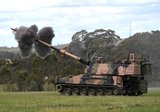Australia’s enhanced NASAMS air defence system comes together
The first fire direction centre and Mk 2 canister launcher have been handed over to Raytheon Australia. (Photo: Kongsberg Defence australia)
Prime contractor Raytheon Australia recently received National Advanced Surface-to-Air Missile System (NASAMS) fire distribution centres and Mk 2 canister launchers from Kongsberg Defence Australia (KDA).
This marked another milestone on the Australian Army’s path to fielding the enhanced NASAMS air defence system. The first canister launchers had reached Australia from Norway mid-year following factory acceptance tests.
KDA stated that it ‘assembles, integrates and tests fire distribution centres (FDCs) with its workforce in Adelaide, with each FDC comprising approximately 10,000 components, the vast majority manufactured by Australian supply chain partners’. The FDC fits inside a 13ft container and it is carried
Already have an account? Log in
Want to keep reading this article?
More from Land Warfare
-
![K9 rolls on as Egypt unveils systems, Australia fires and Vietnam and Norway place orders]()
K9 rolls on as Egypt unveils systems, Australia fires and Vietnam and Norway place orders
Hanwha Aerospace’s tracked K9 Thunder 155mm/52-calibre self-propelled howitzer has had notable success in the market over the past few years in Europe and Asia, with Poland alone ordering 316 systems.
-
![De-Risking the Future: Manufacturing Certainty for Unmanned Systems]()
De-Risking the Future: Manufacturing Certainty for Unmanned Systems
How strategic manufacturing partnership solves the industrialisation triad — Scale, Compliance and Cost — for hyper-growth defence tech innovators.
-
![Battlefield mobility, made in the UK]()
Battlefield mobility, made in the UK
How does Britain ensure that we can preserve the lives of our soldiers and allies – now and in the future – with homegrown innovation and resilient domestic manufacturing? At Pearson Engineering, we are proud to be a central part of the answer to this increasingly important question.






















